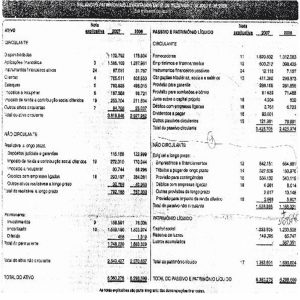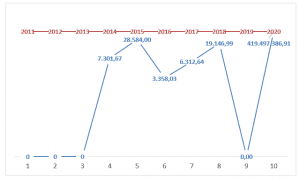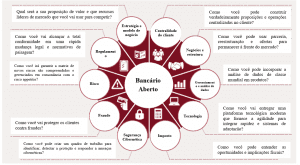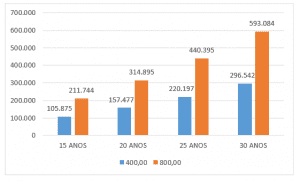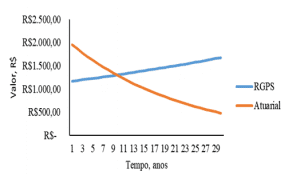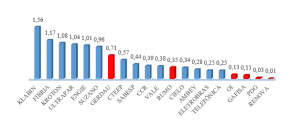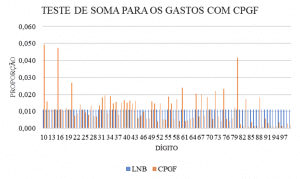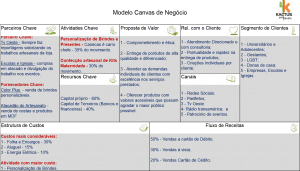BRANDÃO, Matheus Miranda [1]
BRANDÃO, Matheus Miranda. The importance of Internal Control to prevent Fraud in a upholstery Industry. Multidisciplinary Core scientific journal of knowledge. 03 year, Ed. 06, vol. 05, pp. 95-110, June 2018. ISSN:2448-0959
Summary
The present scientific work has as its main objective to analyze and identify the procedures and policies adopted in the internal control of the company, with the aim of contributing to the improvement of the sector within the organization. Initially, concepts were submitted on the internal control and your importance in the organizations, in order to support the study and provide adequate improvements to the end of it. As a qualitative research sought to analyze and identify varieties of factors that contributed to the deficiency in internal control system. With the obtained results, it was observed that the company seeks to utilize some methods related to internal control, but still has weaknesses in your system, which will bring security and control fixed to your proper management.
Keywords: Internal Micro Control, Errors, Fraud.
1. Introduction
Accounting information generated by internal control are of paramount importance so that administrators can be aware of everything that goes on in the company, in order to protect assets and prevent errors or irregularities. Internal control is an essential organization plan to aid a company's assets and check the fidelity of the accounting data. (AICPA, 1991).
The control of business management has experienced a considerable conceptual expansion, with the emergence of new approaches that incorporate new concepts, much borrowed from other areas (economics, psychology, sociology, administration, etc.) (GARCIA and SALAS, 1999). ·.
The development of a system of internal corporate control helps prevent errors, fraud and inefficiency also call management system, as well as ensure the fidelity of the accounting and fiscal records, demos, information and formal reports, in order to establish and meet the reality of management. (CHRISTY, 2011).
For the proper procedure to clear goals and objectives, companies seek ways to further increase the probability that both are achieved, so they will have more accurate information so that you can have an excellent management. (SANTOS, 2012).
Thus, this work is based on the following question: what is the importance of internal control in the search for prevention of fraud in a company? Specifically, it is intended to detect any problems in the control in order to suggest improvements to the system.
Some tools of internal control are needed both to meet the tax control, as to facts within the company.
Thus, the main objective of this study is to analyze and identify the procedures and policies adopted in the internal control of the company.
This work is justified, the relevant importance that suitable internal control exercises in order to prevent fraud, because an internal control done efficiently provides greater security of patrimony of the entity, preventing, monitoring and auditing in the enterprise.
For academia, this research provides benefits with respect to another source of information on internal control. And becomes of paramount importance, for entrepreneurs, who have deficiencies in the measures adopted for the elaboration of an efficient internal control, because this work presents effective tools and information for a proper administration.
2. Theoretical framework
2.1 Internal Control
The Institute of internal auditors of Brazil, Audibra rules (1992, p. 48), records that:
(…) internal controls should be understood as any action taken by the Administration (so understood both the senior management as suitable managerial levels) to increase the likelihood that established objectives and goals are met. The senior management and managers plan, organize, direct and control the performance so as to provide a reasonable certainty of completion.
A system of internal control within an organization represents a set of procedures or methods that aim to protect their assets, producing reliable accounting data and help conduct orderly administration of entity. (ALMEIDA, 2012).
Santos (2012), explains that the function of internal control is extremely important, since "the internal control provides the mechanism to prevent chaos, crisis management, fraud and other abnormal events that interfere with the efficient functioning of a Organization ".
The growing use of internal control in the micro comes to enable them to have a better development, a new reality, and the difficult task to remain active in the market, which is becoming increasingly competitive. (SEBRAE, 2003).
The problems of Internal Control are in a variety of factors. As an example may include: sales, manufacturing, purchasing, etc. Having an effective internal control system assumes great importance, aiming at more favorable results and less waste. (CHRISTY, 2012).
In practice, the claim is for the safety of an internal control related to the protection of the assets of the company, with the objective of your visa is whether that invests and what gets really is offering resources and some economic profitability pa RA entity. (CHRISTY, 2012).
The implementation of an internal control system aimed at providing greater security, credibility and integrity to the administrative and accounting reports, minimizing or friars errors in operations performed during the day. "For the importance of control, it is appropriate to examine the growth and diversification of a company." (ATTIÊ, 2011).
You can check that, currently, the managers of micro-enterprises are observing the importance of internal control as a management tool because, in addition to prevent the occurrence of errors or fraud, the internal control system protects the companies procedures fraudulent or illegal that could disrupt the company's operations. (SEBRAE, 2003).
For Christy (2004, p. 79), "is of fundamental importance to use a proper control on each operating system, because in this way achieve more favorable results with less waste."
Completing these statements, Almeida (2010, p. 5) emphasizes that:
(…) with the great expansion of business, understand the need to give greater importance to standards or internal procedures, because an administrator cannot oversee all activities.
2.2 objectives of internal control
The internal control system involves several procedures to Oliveira and D'avila (2002, p. 84), "internal control aims to verify and ensure compliance, rules and policies of the company, including the code of ethics in relations Professional and commercial. "
For Attiê (2010, p. 159), "the objectives of internal control exposed aimed at appropriate security configuration will be applied over the entire company, vertically and horizontally."
The internal control itself, covers a set of resources, methods, procedures and processes with the purpose of safeguarding assets, give accordance to accounting records, have appropriate and effective information, encouraging adherence to standards set, contribute to the company's operational efficiency and assist in prevention practices, errors, fraud, misappropriation and other inadequacies. (CHRISTY, 2012).
According to Chiavenato (2003, p. 613),
The control has a restrictive and coercive function, in order to restrain or restrict unwanted deviations can be, too, "an automatic adjustment in the functioning of a system and, finally, as administrative role, through the planning, Organization and direction ". The administrative function is the most important, because it is through it that there is monitoring of the tasks performed and the evaluation of the activities and expected results, in order to make the company succeed in that has been developed through the planning process.
2.3 types of controls
The internal control establishes appropriate procedures, methods and routines to protect the assets, accounting data reliable and contributes to the coordination of the company's business. (CHRISTY, 2012)
Analyzing the definition of internal control, we observe that it can be represented by accounting controls and administrative controls. Through the accounting and administrative information, the internal control has your training, which have the function of giving protection to the patrimony of the company, to prevent errors or fraud that may happen within the organization. (OLIVEIRA, PEREZ and SILVA, 2009).
Both are important to be highlighted, because the distinction between them is clear. While the accounting control is concerned with the principles that keep the heritage, the administrative controls are geared to the interests of the company's operation. (ATTIÊ, 2011).
2.3.1 accounting Controls
Internal accounting controls are the kind that relate directly to the protection of assets and the validity of the company's accounting records. (JUNIOR, 2012)
According to Christy (2012, p. 423), "the accounting controls comprise the organizational plan and all methods and procedures used to safeguard the heritage and ownership of the items.".
Are usually included the following methods: "separation of functions of bookkeeping and accounting reporting of those linked to operations or custody of values; physical controls on these values; and authorization system and separation. " (ATTIÊ, 2011, p. 192-193).
2.3.2 Administrative Controls
Administrative controls are understood by all methods and procedures adopted by the Administration in order to manage the efficiency at operations, to emphasize the business policy used in the Organization, as well as all of your records financial. (CHRISTY, 2012).
Operational efficiency and methods adopted by the corporate policy are fundamental roles to advance business and both are controlled by the administration. (ATTIÊ, 2011).
Thus, it is clear that the internal controls of administrative attention is more focused on the Organization's systems, the methods and the procedures adopted by the company, aiming at the efficiency and effectiveness of operations. (CHRISTY, 2007).
There is also another vision involving the timing of internal control, where Franco and Marra (2009, p. 267):
The primary means of control at its disposal an administration is accounting. This, however, by bookkeeping, records the facts after your occurrence (consequent), however in other means of control are used to establish the occurrence at the time she checks (concomitant control) and even those who predict the occurrence of the fact in advance.
2.4 importance of internal control system
Attiê (1998, p. 114) says:
The importance of internal control is patent from the moment it is impossible to conceive of a company that does not have controls that can ensure the continuity of the operations and information flow.
The accounting and internal control system shall include the plan of organization and the integrated set of method and procedures adopted by the entity in your asset protection, promotion of the reliability and timeliness of their records and demos accounting, and your operational efficiency (CFC 2010).
Internal control can be defined as a means of organizational planning and procedures adopted within an organization, in order to safeguard its assets, verifying the adequacy and the support of the accounting data, in addition to promoting adherence to the policies defined by the direction ". (MIGLIAVACCA, 2002).
A company that does not have an internal control system is very efficient, even right, useless, and cannot have confidence in the information contained in reports. (OLIVEIRA, PERES, SILVA, 2008).
The internal control confirms your importance in the following Chairman "distorted accounting information can lead to erroneous conclusions and damaging for the company" (ATTIÊ, 2010, p. 192).
2.5 structure and components of the internal control
The system of internal control must have total commitment levels of administration with all the quality of control. (CHRISTY, 2012).
Christy (2012, p. 417) States that: "internal control structure comprises control environment; mapping and risk assessment; control procedures; information and communication; and monitoring. ".
Information and communication used in the internal control system of the entity must identify and communicate and store in a reliable manner all relevant information, in certain periods, in order to permit the achievement of the goals set, guide the decision making and contribute to the realization of all the objectives of internal control. (CHRISTY, 2012).
Each company acquires a system of controls for the development of the Organization, implementation of financial resources, analyze and verify the performance of operational productivity. (CHIAVENATO, 2003).
2.6 fundamental principles of internal control
The upgrade of the internal control system is of great importance for the verification of what was determined in the system, and/or whether the system should not be adapted for new updates. According to Christy (2011, p. 392) "it does not help the company deploy an excellent internal control system without someone to check periodically.
2.6.1 principles of responsibility
The establishment of an internal control system is of full responsibility of the directors of the company. In addition, it has full responsibility to train their employees properly so that they can have full knowledge of what is being sought, in order to identify responsibilities "for any omissions in the performance of transactions the company "(ALMEIDA, 2010, p. 43).
"The duties of officials or internal sectors of the company must be clearly defined and limited, preferably in writing, by the establishment of internal organizational manuals." (ALMEIDA, 2007 p. 64).
2.6.2 principles of internal routines
The directors of the company must define and formalize all the daily routines and control according to Almeida (2010), such routines include: internal and external forms, evidence of executions of control procedures, procedures of the various sectors of the company.
Internal routines also understand "instructions for the completion and internal and external forms destinations.". (CHRISTY, 2013, p. 427).
2.7 definition of micro-enterprises
The definition of the size of a micro enterprise is related to your annual gross revenues, that according to article 3 of the complementary law 123/2006:
The following shall be considered as micro-enterprises or small businesses, the company Manager, simple society, the individual limited liability company and the businessman, properly recorded with the Registrar of Companies or the Civil Registry of People Legal entities, as the case may be, provided that in the case of micro-enterprise, earning, in each calendar year, gross income less than or equal to R $360,000.00 (360,000 dollars).
This criterion used for classifying businesses of enterprises is an important factor for the development of micro-enterprises, allowing such businesses to enjoy the benefits provided for by the law. (GUIMARÃES, 2010).
2.8 Risks
For the internal control is effective is of utmost importance that the Organization has clear objectives. As soon as they are established, the risks must be first identified and later make the necessary measures are taken for the management of the same. (, 2006).
A well structured internal control by the Administration, with measures of effectiveness and reasonable costs, which may provide a reasonable guarantee margin, reducing the risks and irregularities, providing a lower likelihood of fraud. (2013).
2.9 Errors and fraud
For Andrade (1999, p. 31), "fraud can be characterized as a result of irregularities and illegal acts committed against the company, with manifest intention of author.".
"Reliable internal Controls prevent against fraud and still minimize the risk of errors and irregularities, because, by itself, isn't enough to avoid them." (CHRISTY, 2012, p. 433). As an example, you can highlight that the segregation of an operation reduces chance of occurrence of irregularities, but anyway, can't prevent that they occur if any person involved in the process has the intentional act of play any act fraud during the operation. (CHRISTY, 2012).
Hoog and Carlin (2008, p. 91), emphasize that "fraud is the intentional act of omission or transaction handling, tampering with documents, records and financial statements".
According to Christy (2012, p. 433), "fraud still are a common problem and growing the most, due to the weakening of ethical, moral values and the ineffectiveness of internal control.".
Typically, there are two types of frauds, a is related to fraudulent information and the other with misappropriation of assets. Thus, a weakness in internal control ends up generating an opportunity for fraud occur. (Long, 2015).
In relation to the differentiation of the error and fraud in accounting, nicely clarifies Serpa (2002, p. 57):
It is necessary to distinguish between fraud and error in accounting. Fraud is a premeditated action to harm someone. The error is an involuntary action, without the intention to cause given. Although they may occur on the same facts and documents (balance sheets, trial balances, ledgers etc.) are of different characteristics.
3. Methodology
The research is based on a case study that according to Gonçalves (2011, p. 69) "is the kind of research that focuses on a particular case, a significant unit, deemed sufficient for analysis of a phenomenon".
For Marconi and Lakatos (2011, p. 274), case study "refers to the survey with more depth of a given case or human group under all its aspects".
This job is primarily through various procedures aimed at the solution of a problem. In this case, this is an exploratory research, which according to Gil (2014, p. 27), "main purpose develop, clarify and modify concepts and ideas, with a view to formulating more precise hypotheses or searchable issues for studies later. ".
In this way, the data collected for this research were removed from measures adopted by the company, by means of a questionnaire carried out in 11/10/2016, containing 21 questions closed, that was applied to the owner of the Organization in order to find responses to the problem proposed. The upholstered furniture industry has about 30 employees in your staff and operates in the market since 2010 given in several cities of the country.
The information-gathering instrument applied was to questionnaire, which according to Gil, (2014, p. 121).
You can define how the technical questionnaire of investigation consisting of a set of questions that are submitted to the people for the purpose of information on knowledge, beliefs, feelings, values, interests, expectations, aspirations, fears, present or past behavior, etc.
The research agenda is that qualitative, as Marion et.al. (2010, p. 58) "Is the one that seeks to meet the social phenomena through the meanings that they have for people".
Marconi and Lakatos show that (2011, p. 269).
The qualitative methodology is concerned with analyzing and interpreting deeper aspects, describing the complexity of human behavior. Provides more detailed investigations, habits, attitudes, behavior, trends etc.
Qualitative research does not care about numerical representativeness, but with the deepening of the understanding of a social group, of an entity, etc. The researchers who seek to adopt qualitative approach oppose to the assumption that a single template for all the sciences, the social sciences have specificity, which assumes that having its own methodology. (GOLDENBERG, 1997).
4. Reviews and discussions
In line with the objectives of this study, the results obtained through the questionnaire revealed that the company does not have a formalized procedures manual, putting at risk the operational activities developed.
An efficient internal control relies on attention to all professionals who are engaged to him. Thus, it is imperative that a constant analysis of the controls adopted and whether they are providing greater security in operational activities.
The data obtained for this study were extracted from the Manager of the company, which has 35 years of age, having degree high school completed.
Seeking to identify the degree of confidence in your software, the Administrator reported that lacks such reliability, as reported that your system does not have sufficient resources to assist in the management of the internal control. As the system is not fully trusted, the owner and the other assistants are still using some reports made manually to achieve greater security in the control of the Department.
Seeking to determine whether there are procedures in the system, aimed at preventing errors from operating activities developed in the industry, it's been reported that there is only one Conference, which is not done regularly, putting at risk the safety of the operations.
Through the question, if the General mechanisms instituted by the company are observed by all employees of various levels of structure of the company? He reported that the access to these procedures is quite restricted, with only he and two employees involved in the sector.
When asked about the greatest difficulty that involves the internal control in the enterprise, the owner reported that the company has a fragility in receipts, due to a lack of control, thus creating a strong concern with these operations.
One of the strengths highlighted in organization is the communication between the company and the accounting firm, as they both communicate practical and timely manner, which does not compromise the effective control and tax Department staff, which the Office of bookkeeping services.
Another great concept in the entity is the perception of the importance of internal control in the Organization, which has contributed to the improved performance of the activities developed by the company.
Final considerations
This scientific work has demonstrated the importance of internal control in the management of an industry. Before the results, it is concluded that, in the case of a micro-enterprise, uses some internal control mechanisms, both related to the processes as the communication area. Although still in the initial phase the internal control system of the company under study, even with some flaws in certain sectors. The interconnection of internal control is carried out through regular meetings between the owner and the other assistants in the Department, bringing many benefits to the enterprise.
According to the goals set, it was concluded that this research enabled the company concerned, aid management mechanisms of internal control cited in the theoretical framework that can reduce the risk of fraud, and also increase the security of internal control of the company.
The company still does not have a type of evaluation mechanism and efficiency related to fraud prevention, because it is believed that due to your size, it has no risks with respect to this type of problem (cheats). In this way, leaves the company in a delicate situation faced with risks that may occur.
The lack of control of receipts, generated from a weakness of the software adopted, is characterized as a situation that negatively affects the development and goals of the company. These possible failures in the industry generate a possible audit risks the Department entity.
During the delivery of results, recommended the use of a new internal control management software in the industry, so this will help with necessary tools for a more effective control and that can generate necessary information and trusted decisions processes of the organization.
In addition, it becomes indispensable to the computerization of the sectors still proceed through spreadsheets or reports done manually, so that offer increased efficiency and effectiveness of operational and administrative processes, improving the company's competitiveness on the market and providing significant increase of your profitability.
It also recommended the establishment of an internal control manual where listed in the operating instructions, rules and administrative guidelines to be adopted by the members of the entity.
Also recommended to the Manager of the company a way to professional training and training for industry operators work more practice, more safely, so that the profitability of the entity is even greater.
It appears then, that the internal control becomes essential for any company that you are interested in obtaining an effective control of your assets. You can apply the system you prefer as long as there is confidence in relation to information generated from the software. Thus, it is essential to contain mechanisms that can detect errors or irregularities in the internal environment of the company.
Bibliographical references
AICPA. Audit Procedures Committee of the American Institute of Certified Public Accountants, 2001. Available at: http://www.aicpa.orgl/access: on 12 Aug. 2016.
Marcelo Almeida Cavalcanti. Audit-A modern and complete course: texts, examples and exercises. 7. Ed. São Paulo: Atlas, 2010.
Marcelo Almeida Cavalcanti. Audit-A modern and complete course/Chandra Almeida-8. Ed. – São Paulo – Atlas, 2012.
ANDRADE, Armando. Effectiveness, efficiency and economy: how to achieve them through appropriate internal control systems. São Paulo: a. Andrade, 1999.
ANDRADE, Maria Margarida de. Introduction to methodology of scientific work: preparation of jobs on graduation. 5. Ed. São Paulo: Atlas, 2001.
ATTIÊ, William. Auditing: concepts and applications. 3. Ed. São Paulo: Atlas, 2006.
ATTIÊ, William. Auditing: concepts and applications. 6. Ed. São Paulo: Atlas, 2011.
AUDIBRA RULES-Institute of internal auditors of Brazil. Brazilian standards for the practice of internal audit. 2. Ed. São Paulo: Audibra rules, 1992.
CHIAVENATO, Neena. Administration in new times. 2. Ed. Rio de Janeiro: Campus, 2003.
FEDERAL ACCOUNTING COUNCIL. NBC T 11: Independent auditing standards of financial statements. Brasília, 2010. Available in: < www.portaldecontabilidade.com.br=""> </>. Access on 15 June 2016.
CHRISTY, Silvio Appeared. Managerial accounting: theory and practice. 3. Ed. São Paulo: Atlas 2004.
CHRISTY, Silvio Appeared. Accounting audit: theory and practice. 4. Ed. São Paulo: Atlas, 2007.
CHRISTY, Silvio Appeared. Accounting audit: theory and practice. 7. Ed. São Paulo: Atlas, 2011.
CHRISTY, Silvio Appeared. Accounting-Audit Theory And Practice. 7. Ed. São Paulo: Atlas 2012.
CHRISTY, Silvio Appeared. Accounting-Audit Theory And Practice. 8. Ed. São Paulo: Atlas 2013.
DAYS, Sergio Vidal dos Santos. Audit of organizational processes: theory, purpose, methodology of work and expected results. São Paulo: Atlas, 2006.
FRANCO, Hilarious; MARRA, Ernesto. Accounting audit: 4. Ed São Paulo: Atlas, 2009.
GIL, Antonio Carlos. How to develop research projects/Antonio Carlos Gil. -5. Ed. São Paulo: Atlas, 2010.
GIL, Antonio Carlos. Methods and techniques of Social research. 6. Ed. São Paulo: Atlas, 2014.
GOLDENBERG, M. The art of search. Rio de Janeiro: Record, 1997.
GARCIA, Josir Simeone, SALAS, Joan M. Amat. Management control: a contextual approach and organizational. 2. Ed. São Paulo: Atlas, 1999.
GONÇALVES, Elisa Parker talks about initiation to scientific research. 5. Ed. Campinas, SP: Publisher Alinea, 2011.
GUIMARÃES, Tan Blumenthal. Legal aspects and internal controls in the micro and small companies. 2010. Completion of graduate work in accounting. Universidade Federal do Rio Grande do Sul. Porto Alegre. 2010.
HOOG, Wilson Alberto Zappa and CARLIN, Everson Luiz Breda. Manual of accounting audit of business companies: according to the new civil code – Law 10,406/02. 2. Ed. Curitiba: Juruá, 2008.
Junior, José Hernandez Perez. Audit of financial statements: standards and procedures. 5. Ed. São Paulo: Editora Atlas s.a., 2012.
Complementary law nº. 123 Establishes the National Statute on microenterprise and small business from 14 December 2006. Available at: http://www.planalto.gov.br/ccivil_03/leis/LCP/Lcp123.htm. Access in 25. Out. 2016.
LISBON, Ibrahim. Internal audit manual: concepts and practices to implement the internal audit. Available in: < http://www.maph.com.br/=""> 2013. Access in: 19 Oct. 2016.
LONG, Claudio Gonçalo. Audit manual and Review of financial statements: New Brazilian and International Standards on auditing. 3. Ed. São Paulo: Atlas, 2015.
MARCONI, the Marina; LAKATOS, Eva Maria. Scientific Methodology. 6. Ed. São Paulo: Atlas, 2011.
MARION, Jose Carlos; DAYS, Reinaldo; TRALDI, Maria Cristina; MARION, Marcia Maria Costa. Monograph for the courses of Administration, accounting, and economics. 2 Ed. São Paulo: Atlas, 2010.
MIGLIAVACCA, Shabbar. Internal controls in organizations. 1. Ed. São Paulo: Edicta, 2002.
OLIVEIRA, Luis Martins, PASCUAL JR., Jose Hernandez, SILVA, Carlos Alberto dos Santos Silva. Strategic controllership, 4. Ed. São Paulo: Atlas, 2008.
OLIVEIRA, Luis Martins, PASCUAL JR., Jose Hernandez, SILVA, Carlos Alberto dos Santos Silva. Strategic controllership, 5. Ed. São Paulo: Atlas, 2009.
OLIVEIRA, Marcelo A. Malik; D'avila, Mark, Mark. Concepts and techniques of internal controls of organizations. São Paulo: Nobel, 2002.
Santos, s. of. The Comptroller as a management tool in the costing of a construction company. Available at: http://www.eniac.com.br/?s=RevistaCientifica%20arquivos%202_A%20Controladoria%20como%20ferramenta%20de%20Gest%C3%A3o_Osmildo.pdf. 2012. Access in: 09 Set. 2016.
SEBRAE-Conditions and Survival and mortality rates of Micro and small enterprises in Brazil. 2003-2005. -available in: <http: www.biblioteca.sebrae.com.br="">.</http:> 07 Set access. 2016.
SERPA, Julius Cesar Lopes. Accounting fraud, deceit or guilt. João Pessoa, 2002. Available at: http://.www.contadorperito.com. Access in 27 to Aug. 2016.
THE UNIVERSITY OF BRASILIA. Concept and interpretation of Internal Control. Available in: <http: www.unb.br/administracao/auditoria_interna/artigos/conceito="" _e_interpretacao_de_controle_interno="">.</http:> Access in: 21 May. 2016.
[1] Accounting course-College Univértix

